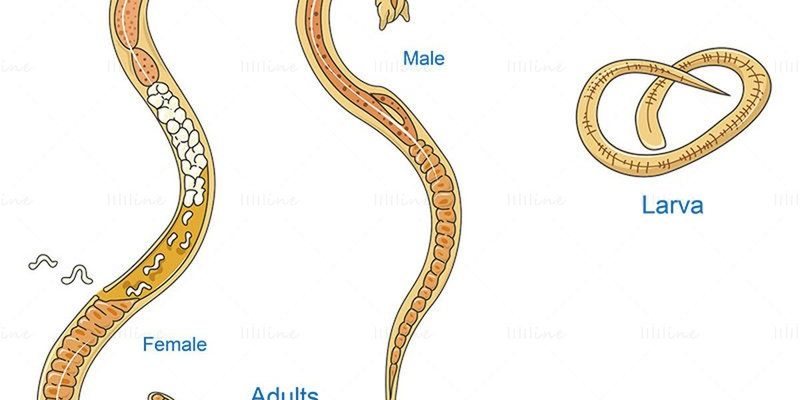
Trichinella spiralis is a type of roundworm usually found in undercooked meat, especially pork. Once it makes its way into the human body, it has some fascinating—and frankly, quite clever—methods for feeding itself. In this article, we’ll break down its feeding mechanism step-by-step, so you can understand exactly how it survives and thrives inside its host.
What Is Trichinella Spiralis?
Before diving into how it feeds, let’s get to know Trichinella spiralis a bit better. This tiny worm is a muscle parasite that infects a range of animals, primarily pigs, but it can also affect humans. The lifecycle of this parasite is pretty remarkable. When a person consumes undercooked or raw meat containing juvenile larvae, these larvae are released in the intestine, where they mature into adults.
Think of it as a sort of home invasion—but instead of robbing you blind, Trichinella spiralis is more interested in snatching up your nutrients. Within a few weeks, these tiny invaders can reproduce inside your intestines, leading to a chain reaction of new larvae entering your bloodstream and finding their way into muscle tissues.
This is where the feeding begins. But how exactly does this parasite go from being a tiny larva to a fully-grown worm?
The Lifecycle of Trichinella Spiralis
To understand its feeding mechanism, we first need to take a closer look at the lifecycle of Trichinella spiralis. It begins when someone eats infected meat. The larvae are protected by a cyst that dissolves in the stomach, allowing them to enter the intestines, where they mature and reproduce.
After mating, the female worms release larvae into the bloodstream. This is a crucial stage because it’s at this point that they leave the intestines and travel to muscle tissues throughout the body. Here, they encyst themselves, creating a cozy little home that’s both safe and nutrient-rich.
Now, the question pops up: How do these encysted larvae get the nutrients they need to survive? It’s all about their clever adaptation.
How Trichinella Spiralis Feeds
Once in the muscle tissue, Trichinella spiralis survives by feeding off the nutrients present in that tissue. It doesn’t have its own digestive system like we do; instead, it relies on the host’s body to keep it alive. By encysting itself within muscle fibers, it gains access to essential nutrients and proteins that the host is using to maintain muscle health.
In a way, you can think of it as Trichinella spiralis hijacking your dinner. While you’re busy using carbohydrates and proteins for energy, this little worm is munching away on those same nutrients, all while hiding away in the muscle.
The Role of Muscle Tissue
Muscle tissue plays a vital role in the feeding mechanism of Trichinella spiralis. When larvae encyst in muscle fibers, they create a protective capsule around themselves. This capsule allows them to evade the immune system of the host, making it much harder for your body to detect and eliminate them.
Also, muscle tissues are rich in blood supply, providing a steady stream of nutrients that the parasite needs. This is another reason why Trichinella spiralis targets muscle—it’s like a buffet! The larva can feed off the amino acids and glucose in those muscles for extended periods, sometimes for years.
As they grow and feed, they continue to deposit more larvae in the muscle, leading to a cycle of infection that can be hard to break. So, you might be wondering how this affects the host.
Effects on the Host Body
The presence of Trichinella spiralis can lead to a range of health issues. Initially, symptoms might include abdominal pain, diarrhea, and nausea. As the infection progresses and the larvae migrate into muscle tissue, muscle pain, fever, and even swelling can occur.
Here’s the thing: These symptoms are often mistaken for other illnesses, which can make diagnosing a Trichinella spiralis infection tricky. The immune response can also cause further discomfort, as your body tries to fight off these unwelcome guests.
In serious cases, the larvae can actually cause damage to muscle tissue, leading to long-term complications. It’s a reminder that our bodies can be quite hospitable—sometimes too hospitable!
Preventing Trichinella Spiralis Infection
Given how sneaky Trichinella spiralis can be, let’s talk about prevention. The best way to avoid infection is through proper cooking practices. Cooking pork and wild game thoroughly—reaching an internal temperature of at least 145°F (63°C) and letting it rest for three minutes—kills any larvae present.
If you’re someone who enjoys hunting or cooking wild game, be cautious. It’s essential to get your meat from reliable sources or to freeze it for several weeks before cooking, as this can help kill the larvae.
Remember that prevention is key. Being mindful of how we prepare our food can save us from a lot of trouble down the road.
The Future of Research on Trichinella Spiralis
Scientists are continually studying Trichinella spiralis to uncover more about its feeding mechanisms and lifecycle. Understanding this parasite not only helps in developing better prevention strategies but also sheds light on its evolution and adaptability.
For instance, researchers are exploring the genetic makeup of Trichinella spiralis to learn how it adapts to survive within different host environments. These findings could lead to new treatments or vaccines to combat infections.
In a world where food safety is becoming more critical, research on parasitic infections like Trichinella spiralis reminds us of the delicate balance we navigate in our diets and ecosystems.
The feeding mechanism of Trichinella spiralis is a fascinating and complex process that highlights the resilience of this tiny parasite. By understanding its lifecycle and how it feeds off our muscles, we gain valuable insights into both prevention and treatment strategies. Remember, safe cooking practices are your best defense against these unwelcome guests.
So, the next time you savor a delicious pork dish, think about the importance of cooking it thoroughly. After all, you want to enjoy your meal—not share it with a parasite!

